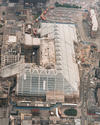 By 1950 the largely industrialised Clyde banks had fallen silent leaving a landscape of shuttered buildings and unmoving cranes. Custom House Quay was landscaped in the 1970s and the last riverside remnant of Tobacco Lord Glasgow, the baroque mansion of Robert Dreghorn (Bob Dragon), became a carpet warehouse and was then demolished. Investment returned with the glazed tent of the St Enoch Centre replacing the derelict railway station by Reiach & Hall with GMW (1988), but the high-tech restoration of the interior of the Briggait Fishmarket into offices and restaurants by ASSIST (1985-6) failed. The nautically inspired Carrick Quay flats by Davis Duncan (1990) eventually reinvigorated the area.
By 1950 the largely industrialised Clyde banks had fallen silent leaving a landscape of shuttered buildings and unmoving cranes. Custom House Quay was landscaped in the 1970s and the last riverside remnant of Tobacco Lord Glasgow, the baroque mansion of Robert Dreghorn (Bob Dragon), became a carpet warehouse and was then demolished. Investment returned with the glazed tent of the St Enoch Centre replacing the derelict railway station by Reiach & Hall with GMW (1988), but the high-tech restoration of the interior of the Briggait Fishmarket into offices and restaurants by ASSIST (1985-6) failed. The nautically inspired Carrick Quay flats by Davis Duncan (1990) eventually reinvigorated the area.
 The downstream scene was grim. The stupendous classical warehouses by John Stephen in James Watt Street fell derelict and the Italianate Sailors' Home was demolished. A master plan for Atlantic Quay (1988) by BDP, followed by a master plan for Pacific Quay by the Parr Partnership, progressively transformed the gridded streets between Argyle Street and the Broomielaw into a glossy office and hotel district so that it now feels as American as did Glasgow's downtown in the late 19th and early 20th century.
The downstream scene was grim. The stupendous classical warehouses by John Stephen in James Watt Street fell derelict and the Italianate Sailors' Home was demolished. A master plan for Atlantic Quay (1988) by BDP, followed by a master plan for Pacific Quay by the Parr Partnership, progressively transformed the gridded streets between Argyle Street and the Broomielaw into a glossy office and hotel district so that it now feels as American as did Glasgow's downtown in the late 19th and early 20th century.
 Instead of filling Queen's Dock with Strathclyde Regional Council's headquarters, as proposed by the joint winning scheme in a 1972 Ideas Competition by Renton Howard Wood, the Scottish Exhibition and Conference Centre by James Parr & Partners was opened there (1984), with the indifferently connected acontextual Clyde Auditorium (the Armadillo) tagged on by Norman Foster & Partners (1997).
Instead of filling Queen's Dock with Strathclyde Regional Council's headquarters, as proposed by the joint winning scheme in a 1972 Ideas Competition by Renton Howard Wood, the Scottish Exhibition and Conference Centre by James Parr & Partners was opened there (1984), with the indifferently connected acontextual Clyde Auditorium (the Armadillo) tagged on by Norman Foster & Partners (1997).
The construction of a new footbridge and the 1988 Glasgow Garden Festival gave impetus to the derelict Prince's Dock and it is now defined by Richard Hordern's Tower rising beside the shiny glandular-shaped Scottish National Science Centre (2000) by BDP. To accentuate the urban incoherence, an austere glazed box by David Chipperfield for the BBC's Scottish Headquarters is soon to join them.